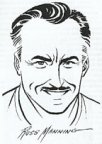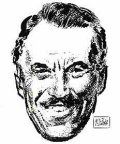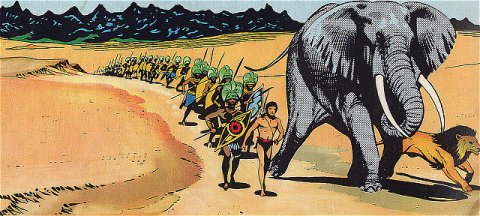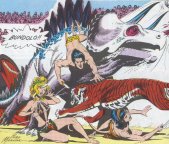In our scientific age the close affinity of man to other animals,
in fact the basic animal nature of man himself, is apparent. The sub-conscious
levels underlying our entire race has always been aware of our animal nature,
but social-cultural aspects of our lives have at times denied and smothered
complete realization of all instincts. During historical periods when spiritual-intellectual,
rather than animal, qualities in man were being overemphasized, symbols
of man's desire for balance were at time evident.
Animal-headed gods appeared in Ancient Egypt where the entire life of
the people was based on an intellectual and spiritual preparation for a
hereafter. During the medieval ages, when man's "baser" instincts were
drastically over-ridden in the struggle to assert spiritual guidance to
man's every effort, werewolves welled up from a deep racial realization
of need. The beast-man to balance the angel-man.
Then came the machine. . . the industrial revolution. . . and mankind
was subjected to another anti-instinctual unbalance. Almost immediately
animal man tried to come to the rescue. Rudyard Kipling created Mowgli.
But somehow the folk hero was incomplete. Mowgli is not mankind operating
at the level of animals. . . and Mowgli's animal friends are intellectuals,
almost philosophers. . . not true animals. Mowgli and his friends
think
too much.
Then from the hands of Edgar Rice Burroughs came an animal-man, suckled
at the breast of man's nearest kin. . . a man knowing nothing of machines,
and needing them even less.
Tarzan. . . folk hero. . . the end result of a need that shoved itself
in the Egyptian animal-headed men, gradually refined and distilled through
the centuries. All credit to Mr. Burroughs, when he created Tarzan, he
created him perfect. . . fifty years have seen no improvements. Like Mowgli,
Tarzan might have come to us flawed, and the race of man caused to divide
up between two blurred symbols the chore of relieving the strains of the
machine age.
Did Edgar Rice Burroughs create Tarzan? If allowing a basic need of
our race to flow from his fingers free of stylish vagueness and unmarred
by murky philosophy. . . if allowing a folk hero to leap fullborn and vital,
deep into the consciousness of the entire world, can be merely called creating.
. . then Edgar Rice Burroughs created Tarzan.
There may be a Tarzan fan somewhere who has no particular favorites
among the various interpretations of the ape-man - but he isn't seated
at THIS typewriter. A Tarzan movie, or comic strip, or illustration that
"just ain't the ape-man" causes me as much anguish as seeing may own name
misspelled.
As to so many others, to me Tarzan EXISTS. Now, I don't think that I,
or anyone else, could go to a tree-house in Tanganyika right now and shake
his hand -- I mean that he has a separate, distinct, and completely defined
world all his own, and not matter what happens in Tshombe's Congo, or how
many housing developments they throw up in Kenya, Tarzan's Africa will
not be much harmed or altered. But a poor drawing, or a poorly done movie,
will eventually ruin him.
So far we've been lucky. There have been enough fine interpretations
to outweigh the incompetents and the Jungle Lord still lives. But we've
all been too inclined to tolerate the bad and merely adequate renditions,
and I believe we should become more critical. A good solid base of constructive
criticism almost always produces a better product.
Here, then, is my countdown of the various interpreters whose work I
have seen, from those mighty talents that have done so much to make the
ape-man REAL, to those who have almost killed the legend.
First must come Burroughs' Tarzan. Yep -- BURROUGHS' Tarzan. As I've
stated elsewhere, if ERB hadn't created Tarzan, someone else would have.
A folk hero was crying to be born -- an animal-man raised by animals, who
with only his bare hands and his animal friends can handle any situation
anywhere on earth -- and Edgar Rice Burroughs got the call. The idea has
been tried before and since, but nowhere is the image so universal, so
powerfully compelling, and so simply understandable. So Burroughs' Tarzan
stands first -- perfect, unimprovable -- and all since have been either
interpretations or copies.
Of all the VISUAL Tarzans, Hal Foster's rates highest, both as fine
art, and because it comes closest to Burroughs' description of the ape-man.
It is Foster's conception of Tarzan -- the lion or leopard skin trunks;
the shape of head, hair and features; and the mature, capable, manly figure
that seems to hit exactly the universal image that comes with the thought
of an ape-man, and all successful renditions of animal-men since have followed
his lead. Among the one or two other visual Tarzans that come close to
Foster's for "rightness" was Johnny Weissmuller's portrayal (of which more
later) and since the movies and the comic strip both produced their greatest
Tarzan at the same time (the early '30s) I'm uncertain to what extent each
influenced the other. I do believe I detect a strong influence of Tom Mix
in the way Foster drew Tarzan's face.
Tarzan was lucky. Foster is one of the finest storytellers and illustrators
of our time, and the Jungle Lord hd drew is perfectly believable, in a
jungle better than real-life ones. His Great Apes are completely bestial,
yet somehow near-human.
In this respect the movies have always failed, usually miserably. The
better films must omit the Great Apes entirely, and one of the several
reasons that the comic strip is a better Tarzan vehicle -- and Hal Foster
drew the greatest Tarzan in comics.
Of the Tarzan movies, only the earliest and best of those starring Johnny
W. can compare with Foster's Tarzan. Foster, in the comic strip format,
had the advantage of being able to depict anything that Burroughs could
describe -- but the movies had the incredible Johnny W., with his perfect
ape-man head, half civilized, half throwback.
Two Johnny W. movies, TARZAN THE APE MAN, and TARZAN AND HIS MATE, with
their wonderfully pagan stories and better than real-life sets, are almost
outside Burroughs and competing with him, they are that great. But since
they are at least based on ERB's creation, they must inevitably only follow
him.
Next comes a very hard choice. Three artists, each of whom illustrated
enough of Tarzan for us to be sure what the Jungle Lord meant to him, and
each is distinctly different. They are Jesse Marsh, Hogarth and J. Allen
St. John. Jesse comes closest to Burroughs and the universal Tarzan, Hogarth
blasts us with a strong forceful image, and St. John shows us an unique
Tarzan.
Jesse Marsh's Tarzan is a massive monolithic figure more primeval Cro-magnon
than English lord, as if the boy's early environment overshadowed his heritage
and imprinted more of the animal on the man. Though Jesse has suffered
from bad scripts more than any other of the illustrators, his fine sense
of design and storytelling have made the Tarzan comic book stand out in
quality among all the other on the stands. In fifteen years, Jesse has
illustrated almost every Tarzan story in over 150 comic books. He may well
have drawn more Tarzans than all the others COMBINED!
Hogarth's Tarzan seems to wander away from Burroughs. Dynamic, strong,
visually exciting and full of superbly drawn action, still Hogarth's drawings
are too stylized in a manner that never seems real. Of the two or three
really well drawn Tarzans, his seems the furthest from having an actual
existence. Here I do not refer to realism, or the world we live in -- neither
Foster nor Marsh are slavish realists, but are rather CREATIVE, their drawings
creating a complete, believable world. Hogarth's drawing is so powerful
and interesting that his images stick forcibly in our mind. but Foster
and Marsh come closer to the ape-man that Burroughs gave us.
St. John's Tarzan is a romantic in the 19th century tradition. Fanciful,
imaginative, and not of this world, we'd feel an undefined something missing
if St. John had never drawn the ape-man. He put the fantasy, the other-worldliness
into Tarzan that everyone else missed, except the master, Burroughs. To
St. John's illustrations goes the mind's eye for what the ant men look
like, or the earth's core, or any of the off-beat touches so much a part
of the legend. His style was perhaps too much of the 1920s, while Tarzan
is timeless, but how we would miss each magnificent masterpiece if he had
never painted them.
Next I would lump all of the Tarzan movies, except those mentioned earlier.
Then back to the comic strip -- and if the ape-man had depended upon Maxon,
Rubimor, Barry, Lubbers and Celardo to keep life in him, he'd have been
long gone. The original books and the films must have sustained him while
the above worked on the strip.
Maxon never seemed to clean up his drawings -- Tarzan had a harder time
swinging through all the black ink smudges than he did through the foliage.
Rubimor's Tarzan was an attenuated, sickly neurotic in a fetid atmosphere.
Barry was just too young, or inexperienced. His David Innes is a callow
fellow and his Tarzan a poor copy of Hogarth. He's done much better since
on the daily Flash Gordon.
Lubbers rushed it.
Celardo, too, suffered from terrible scripts -- and his drawing is still
and unimaginative.
None of these latter illustrators and movie makers seemed to realize
that Tarzan is that inspiring, perfection-demanding creation -- a folk
hero. Only the very best will suffice to keep such a creature vital, because
he epitomizes some deep-felt need for greatness that we can associate with,
an inspiring height to which each of us might aspire. Poor quality in depicting
such a symbol degrades it.
We seem to be on the verge of an improvement in some of the visual Tarzans
-- the movies, the comic strip, and comic books, and plenty of constructive
criticism can only help this movement along. So let the producers hear
what we thing of their efforts, stressing quality in their interpretations.
And let's REALLY BLAST them every time poor renditions kick our hero in
the teeth.
Russ
Manning Letter to the Editor







